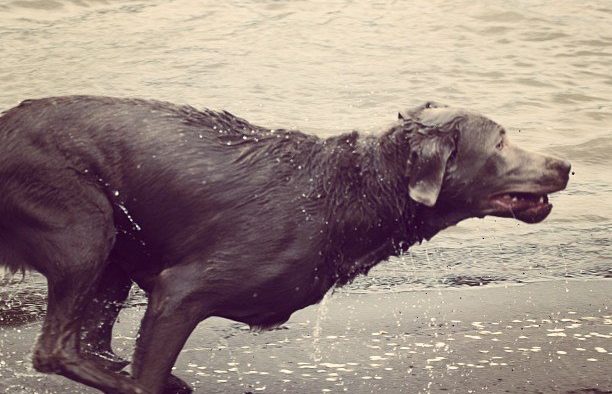Why Dogs Get Lost (and how to stop the cycle)
Share

Every year, countless dogs end up lost, injured, at a shelter or (in many cases) euthanized, because they escaped from their loving homes.
I’ve written this article to address the causes and to provide some helpful suggestions on how to avoid your dog feeling the need to jump the wall or rush out of the front door and hightail it down the street never to be seen again.
These are some of the most common reasons why dogs choose to jump the fence, bolt out of the door or sneak out of the garage when you’re not looking:
Breed Specific Reasons
Some breeds are more prone to escape than others. These include the Northern Breeds (e.g. Siberian Husky, Alaskan Malamute, Shiba inu, American Eskimo, Spitz and numerous hound types to name but a few), hunting dogs (e.g. terriers of any kind), territorial/guarding breeds (e.g. Doberman, Rottweiler), and many more.
Some breeds are naturally more physically able to escape than others (e.g. Treeing Walker Coonhound).
They’re Not Fixed
Unaltered dogs (those who are not spayed or neutered) are more likely to escape the yard. Males can smell a female in heat from miles away and will pursue her for days, even going without food or water if necessary.
See this fascinating video documentary about dogs in pursuit of a female in heat in South Central Los Angeles:
Females in heat are also likely to escape when they are ready to mate.
They’re Bored
This is a big one! Dogs that are left outside for long periods while their owners are away can easily become frustrated and bored.
Life inside the yard must seem so boring compared with what’s going on outside the fence – people, other dogs, squirrels, birds, moving vehicles, the neighbors dogs and kids, etc all passing by. Dogs will escape yards and homes because they are bored. This is also a primary reason for pacing fences, barking and more.
Fear
Dogs who are afraid of storms, fireworks and loud noises might attempt to run away to find safety.
Separation anxiety is another reason why dogs leave the comfort of their homes and yards. Dogs who are very stressed by being left alone might escape to go looking for their owners
Careless Visitors
Whether it’s a well-meaning neighbor, gardeners, or pool service people – there are times the gates are just accidentally left open. Keep in mind that there are plenty of pranksters who think that opening an unlocked gate is just funny. It’s not…
Always keep a padlock on your gate – this will protect your pet from getting lost or stolen.
Because it’s fun!
The dog gets to run around the neighborhood experiencing lots of new smells, sights and sounds and he is far from bored. He probably has a good chance of engaging in a lovely game of “chase” with his owner trying to catch him!
Practical Prevention
Getting out of the car – owner opens the door and the dog bolts. It’s a scenario that repeats itself daily. Make sure your dogs understand the etiquette for getting out of a vehicle. It can save their lives and your own.
Microchip your pet and update the microchip information each year. Your dog cannot be returned to you if the wrong information is listed. If you don’t recall the microchip company, you can access this information by asking your veterinarian to scan your dog. Lots of dogs have microchips that contain inaccurate outdated information.
Use an “ex-pen” near the front door to keep the dogs away from the door when you have to open it.
Don’t fool yourself that a collar is enough. Most dogs who might have started out with a collar on, end up being found without it. They just come off!
Your collar should have tags showing rabies vaccination information and your phone number. I like these collars that are embroidered with the phone number:


Keep gates locked at all times – from the inside. If you don’t have a locked padlock, at least have something that physically prevents the gate from being opened by dogs jumping up and hitting the catches. Lots of dogs can open gates.
Puppy Bumpers: For small dogs and puppies who could easily slip through a wrought iron fence or small gap, try a Puppy Bumper. These help ensure pets can’t squeeze through the small openings in gates or wrought iron.

Make sure your fencing isn’t easy to climb. Wooden fences should have struts going horizontally at an angle that makes it difficult for dogs to get a foothold.
Restricting Access
Restrict Access to Fence: It’s a good idea to block off your dog’s direct access to the side of the house where he can stand and look through the gate – just putting some distance between the dog and the gate reduces their inclination to challenge the gate. Any home improvement store sells very affordable plastic coated wire fencing which can be easily set up. I use this to protect air conditioning machines from destructive puppies too!


For determined proven escape artists you might want to install “coyote rollers”. Read Fencing Solutions to Keep Dogs Contained for some wonderful ideas (and to learn more about coyote rollers).
Make sure your gates have an “auto close” spring attached to close the gate automatically.
Resolving the Problem
Don’t leave your dog outside unattended for long periods of time. They are safer in a large crate in the house.
If you must leave Fido outside then please make sure he has adequate shade and water and try some of these suggestions:
- Spay or Neuter your dog
- Alleviate Boredom – Boredom Busters are things that can keep your dog occupied in a harmless way, here are some examples:
- Stuffed Kongs – see my Kong Stuffing Recipes under the Files section in my Facebook Group called Be Kind To Dogs.
- Scatter kibble and/or treats around the yard.
- Leave lots of different types of toys around.
- Hide kibble/treats around the yard. You can hide small morsels of food on window sills, under old buckets, in treat dispensing toys (Tricky Treat Ball, Kong Wobbler, tennis ball with a hole in), under stones, even in a dispenser hanging from a tree – get creative!
- Provide a small paddling pool filled with water.
- Fill a paddling pool with sand and hide toys with treats in so your dog can dig for them.
If your dog is naturally fearful, be sure to provide a safe place for them to hide when he gets scared. This might be a crate, shed or large dog house. Whatever you choose, it should be sturdy, large enough and protected from all the elements and have a comfy bed inside.
Don’t allow your dogs to dash out the door of your home. You should make sure your pets understand an open door is not an open invitation to leave. Read Training Diaries: The Dogs and the Door for a fun look at how you can train your dog to avoid the door. If you still need more info, this is a nice video demonstrating how to teach your dog to not bolt out of the door:
Teaching a reliable “come” – fun method for teaching your dog to come when you call no matter what!









